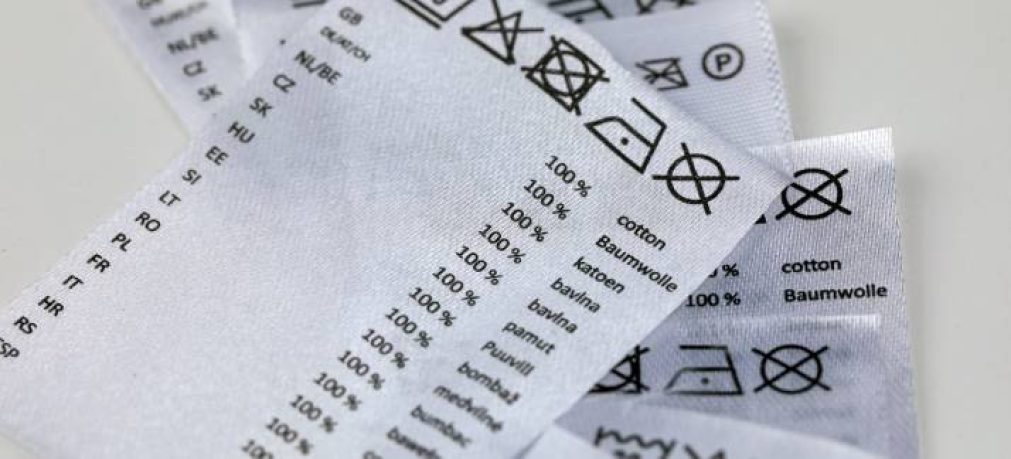When we think of a clothing label, we often picture a technical detail: fabric composition, size, washing instructions… But it’s much more than that. A label is the first conversation between your brand and the person buying the garment. If it’s poorly translated, uses an unfortunate color, or doesn’t comply with local regulations, it can create distrust—or even lead to penalties.
1. Language and translation: translating isn’t the same as speaking your customer’s language
The language on a label is more than just a legal requirement—it’s a way to show respect for the consumer. A garment with information only in English in Mexico or China can feel foreign, careless, or untrustworthy. Moreover, in many countries, the law requires the use of the official language.
For example, in Canada, labels must include both English and French; in Mexico, they must be in Spanish; and in China and Japan, text must appear in the local language.
2. Fiber and composition: each country has its own terms
The list of textile fibers is not universal. What is called “elastane” in Spain is “spandex” in the United States and appears as 氨纶 in China. Using the wrong term can be legally incorrect or even misleading for consumers. A label is also a statement of transparency: naming fibers correctly conveys credibility.
For example, the EU has an official list of valid names; in the U.S., the FTC regulates which terms can be used; and in China, there are very specific requirements regarding percentages and naming.
3. Care symbols: a global language with local dialects
Washing, ironing, and drying pictograms may seem universal, but in reality, they are protected and subject to licensing in many markets. Additionally, some countries require combining them with text in the local language to avoid confusion.
The ISO 3758 standard establishes the international system, GINETEX manages licensing in numerous countries, and in China and Japan, while symbols are accepted, textual clarity is also required.
4. Writing and layout: when text doesn’t flow the same way everywhere
In the West, we read from left to right, but that’s not the case in all markets. A poorly adapted label can feel awkward or even be unreadable. For example, in the Middle East, Arabic and Hebrew are written from right to left. In China and Japan, while horizontal writing is now common, vertical writing also exists. Designing labels with these differences in mind ensures that consumers can read them naturally.
5. Colors: the same shade, different meanings
Colors convey emotions and values, but they don’t always mean the same thing across cultures.
For example, a white label may suggest purity in Europe but is associated with mourning in some Asian countries; red symbolizes luck and prosperity in China but can indicate danger in other contexts; black represents elegance in the West but is linked to bad luck in China; and yellow/gold, which in the West is associated with joy or luxury, is considered sacred in India, requiring greater sensitivity.
Choosing colors without considering these associations can undermine even the best branding strategy.
6. Numbers: superstitions best not ignored
Numbers also communicate, even if subconsciously. Including them in a model name or size numbering can have unexpected consequences.
For example, in China, Japan, and Korea, the number 4 sounds like “death.” In the West, 13 still carries negative connotations in some cultures. In India, the number 8 has unfavorable associations.
7. Sizes and measurements: a maze of systems
One of the biggest headaches in international fashion is sizing. What is a 38 for a customer in Madrid is a 8 in New York, and in Shanghai it’s expressed with a number plus measurements in centimeters. The EU uses centimeters under the EN 13402 standard. The U.S. prefers inches. In Japan, local numbers are used alongside centimeters. In China, sizes combine centimeters with letters and numbers (e.g., 170/92A). And this pattern repeats across almost every market… Including measurements in centimeters is the safest way to avoid sizing confusion.
8. Child safety: a topic that should never be overlooked
Children’s clothing is subject to specific regulations, especially regarding cords, buttons, or accessories that could be hazardous. A brand that fails to comply risks more than fines—it risks its reputation.
For example, in the EU, the EN 14682 standard regulates cords and drawstrings. In the U.S., the CPSC bans cords on children’s hoodies. In China, GB 31701 sets strict safety requirements.
9. Eco-labels: sustainability that resonates in every market
More and more consumers are looking for responsible clothing. But not everyone recognizes the same certifications. Displaying a logo that your audience doesn’t understand can reduce its value rather than add to it.
In the EU, the Ecolabel stands out, and soon the digital product passports will also play a role. In Japan, there is the Eco Mark; in China, the official label is the China Environmental Labelling; and in India, the Ecomark system is used.
10. Culturally sensitive design: beyond compliance, building connection
Label design can be an aesthetic detail, but it can also be a cultural nod that strengthens the connection with the customer.
Depending on the country, small touches in red or gold can convey prosperity, while in others, sobriety and minimalism are valued. For example, in India, bright colors are associated with celebration and energy, whereas in Arab countries, clear Arabic typography demonstrates respect and professionalism. Considering these nuances turns a label from a “mere requirement” into a branding tool.
In short, clothing labels are not just technical support—they are a cultural and legal bridge between the brand and the consumer. Adapting them with sensitivity helps avoid penalties, reduces returns, and, most importantly, builds trust.



